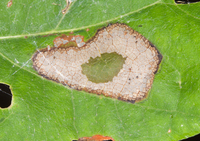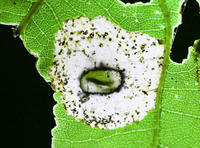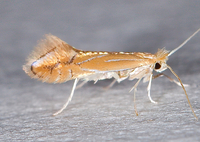
| Recorded by: John Petranka on 2024-08-07
Orange Co.
Comment: A reared adult from Quercus rubra. | 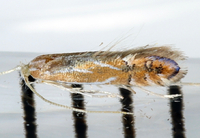
| Recorded by: John Petranka on 2024-08-07
Orange Co.
Comment: A reared adult from Quercus rubra. |

| Recorded by: John Petranka on 2024-08-03
Orange Co.
Comment: Mine containing pupa was found on Northern Red Oak, Quercus rubra. Adult eclosed four days later on 8/7/2024 and was submitted as a separate record (ee companion photos of the adult from 2024-08-07). | 
| Recorded by: John Petranka on 2024-08-03
Orange Co.
Comment: Mine containing pupa was found on Northern Red Oak, Quercus rubra. Adult eclosed four days later on 8/7/2024 and was submitted as a separate record (ee companion photos of the adult from 2024-08-07) |

| Recorded by: Stephen Dunn on 2024-07-30
Orange Co.
Comment: | 
| Recorded by: David George, Jeff Niznik, Stephen Dunn on 2024-06-29
Chatham Co.
Comment: |
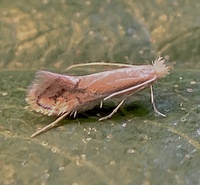
| Recorded by: Ken Kneidel on 2024-06-08
Mecklenburg Co.
Comment: An adult that was reared from a blotch mine on a Quercus alba leaf collected on 6/1/24 and kept outdoors in the interim (see companion photo of the mine). | 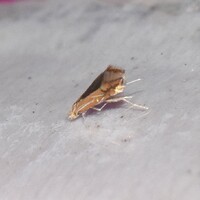
| Recorded by: Jeff Niznik, David George on 2024-06-01
Durham Co.
Comment: |

| Recorded by: Ken Kneidel on 2024-06-01
Mecklenburg Co.
Comment: A blotch mine on a Quercus alba leaf collected on 6/1/24 and kept outdoors in the interim (see companion photo of the adult that emerged on 2024-06-08). | 
| Recorded by: Ken Kneidel on 2024-06-01
Mecklenburg Co.
Comment: A blotch mine on a Quercus alba leaf collected on 6/1/24 and kept outdoors in the interim (see companion photo of the adult that emerged on 2024-06-08). |
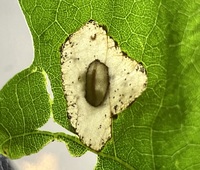
| Recorded by: Ken Kneidel on 2024-06-01
Mecklenburg Co.
Comment: A blotch mine on a Quercus alba leaf collected on 6/1/24 and kept outdoors in the interim (see companion photo of the adult that emerged on 2024-06-08). | 
| Recorded by: David George, Tracy Feldman on 2024-05-21
Wake Co.
Comment: |

| Recorded by: David George, Tracy Feldman on 2024-05-21
Wake Co.
Comment: | 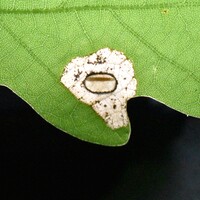
| Recorded by: Jeff Niznik, David George on 2024-05-20
Durham Co.
Comment: |
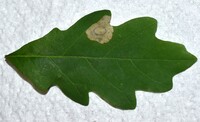
| Recorded by: Jeff Niznik, David George on 2024-05-20
Durham Co.
Comment: | 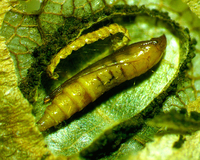
| Recorded by: Ken Kneidel on 2023-12-29
Mecklenburg Co.
Comment: |

| Recorded by: Ken Kneidel on 2023-12-29
Mecklenburg Co.
Comment: | 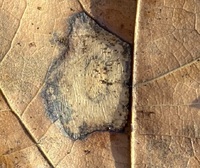
| Recorded by: Ken Kneidel on 2023-12-29
Mecklenburg Co.
Comment: |
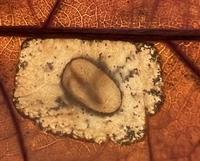
| Recorded by: Stephen Dunn on 2023-11-17
Orange Co.
Comment: | 
| Recorded by: Stephen Dunn on 2023-11-17
Orange Co.
Comment: |

| Recorded by: David George on 2023-10-16
Durham Co.
Comment: | 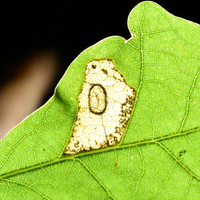
| Recorded by: David George, Stephen Dunn, Jeff Niznik on 2023-08-10
Orange Co.
Comment: |
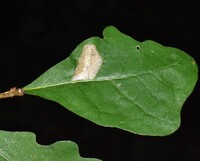
| Recorded by: David George, Stephen Dunn, Jeff Niznik on 2023-08-10
Orange Co.
Comment: | 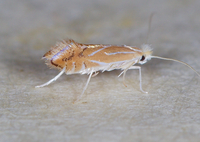
| Recorded by: Jim Petranka on 2023-07-21
Madison Co.
Comment: |
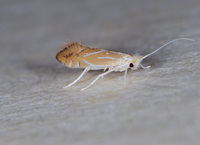
| Recorded by: Jim Petranka on 2023-07-21
Madison Co.
Comment: | 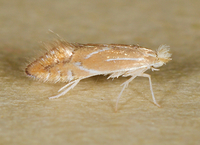
| Recorded by: Jim Petranka on 2023-03-18
Rutherford Co.
Comment: Adult was reared from Chestnut Oak; mine on Oct 21, 2022; adult on March 18, 2023 after overwintering in refrigerator. |

| Recorded by: Jim Petranka and Becky Elkin on 2022-10-21
Rutherford Co.
Comment: Occupied mines were on Chestnut Oak. | 
| Recorded by: Jim Petranka and Becky Elkin on 2022-10-21
Rutherford Co.
Comment: A larva that is in the process of gathering frass to form a pupation chamber. |

| Recorded by: Jim Petranka and Becky Elkin on 2022-10-21
Rutherford Co.
Comment: | 
| Recorded by: Jim Petranka and Becky Elkin on 2022-08-25
Clay Co.
Comment: |
|

 »
»